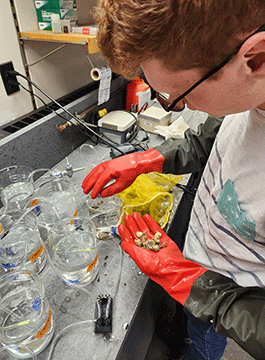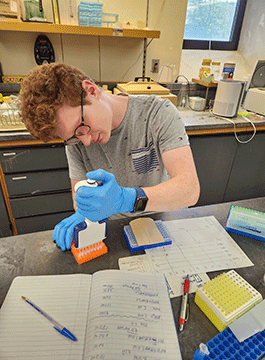News Detail
09/12/2023

Studies have shown that an estimated 94% of the world’s oysters are contaminated by micro-plastics, the microscopic residue released when plastic breaks down in water.
A SUNY Cortland junior biology major this summer set out to learn how all that pollution is affecting the animals, a valuable food source and key player in ocean ecology.
Makiah Poli of Cortland, N.Y., is testing how oysters who live in an estuarine environment — places where saltwater meets freshwater — respond genetically to ingesting a form of pollution that has become endemic to the modern world.
Poli recently completed the early stages of his own original study of how the genes of the bi-valve mollusks respond to a couple weeks spent bathing in an invisible but noxious soup of microplastics.
Poli’s pure science experiment on the sea creatures, under faculty mentor Laura Eierman, offers the potential for a relatively quick way to find out how these organisms react to contact with the increasingly common particles of marine paint, synthetic textiles, household products and other trash that end up in waterways.
“Will their genes express stress?” Poli asks. “We are hoping to see in the samples we took that the stress levels would go down after we remove the plastic from them.”
If his experiment works, it could offer a glimpse at how all animals are potentially impacted by this pollutant.
This fall, he’ll draft an academic paper on the project titled “Response of Stress-induced Genes in Eastern Oysters Exposed to Plastic Leachate,” which he’ll present at next spring’s annual Transformations conference at SUNY Cortland and perhaps to a wider academic audience.
Poli is one of 12 SUNY Cortland undergraduate research summer fellows for 2023 supported through the university’s Undergraduate Research Council. From late May until Aug. 2, the 17-year-old program offered the students an opportunity to focus on their own research project.

Many summer fellows benefit from privately funded Cortland College Foundation scholarships toward their summertime expenses. Poli in particular received a W. Hubert, Ph.D. and Sally Keen Undergraduate Research Summer Fellowship, endowed by the past SUNY Cortland dean of arts and sciences and his spouse. The fellowships cover a residence hall bed if one is needed — Poli did not — a campus research space, and a $4,000 stipend to keep the budding scholars focused on their research. Additionally, faculty mentors including Eierman earned $2,000 to meet with their protégé over the summer.
“All science interests me but I have my sights set on marine biology,” said Poli, who arrived at SUNY Cortland having completed a high school elective in the specialty.
“His project was completely new and novel,” said Eierman, an associate professor of biological sciences who’s starting her eighth year with the Biological Sciences Department and who specializes in marine invertebrates in her own research.
“Some of my other students who have done summer research are coming into a project where they build on a foundation created by other students,” she said. “His was from scratch.”
Early in the experiment, Poli’s own test oysters and placebo — or control group — oysters, which he had collected from Maryland estuaries, were housed in large beakers containing bubbling air stones to aerate the oysters’ environment. Plastic wrap around the glass top helped contain the moisture and he continually fed all the oysters a diet of super-concentrated algae.
Some of the bivalves were then exposed to microscopic plastic pieces and plastic chemical leachate in their salt water for two weeks. After that, they spent another two weeks living in uncontaminated salt water.
Poli then processed all the oysters, removing and freezing their tissue and then systematically extracting all the messenger RNA, to be turned into complementary DNA, part of the process he designed to identify genetic material that would show a reaction to the pollutants.

By mid-summer, he had advanced to the molecular work of amplifying this genetic material from his samples to be used as an efficient tool to indicate how much these genes were being activated in response to stress in both the control oysters and the treatment oysters.
This stage involves identifying several examples of a short nucleic acid sequence that provides a starting point for DNA synthesis, called “primers.” These primers will allow him to isolate and quantitatively measure how much these genes are being used to make proteins in the oyster tissue.
It’s painstaking work because humans haven’t yet identified universal “stressor” genes in oysters, Eierman explained.
Recently, having rejected three of four potential genetic indicators, Poli started over identifying more good primers. Once satisfied that they reflect the animal’s response to the irritant, he will collect the resulting data.
Before college, Poli, 19, had maximized his homeschool experience by continually skipping ahead in his science reading.
“At orientation, (Eierman) was there at the Department Open House along with Dr. (Andrea) Dávalos, talking about what their research is about,” Poli said of the associate professor of biological sciences. “I thought, ‘Oh, that’s what I want to do.’”
Eierman recalled, “The first semester back on campus after pandemic, in Fall 2021, I would hold office hours, and nobody came except Makiah would come to my 8 a.m. office hours to ask questions.”
Poli soon was employed in Eierman’s laboratory in Bowers Hall feeding the professor’s dozens of bivalves rocking in their own biosphere of gurgling, aerated saltwater inside large, shallow blue bins.
“After that, I stayed,” he said.
“When Makiah says he’ll work at it, that means he will put in the effort to have the best understanding of the material that he can get,” Eierman said.
For example, Poli completed a biostatistics course taught by Dávalos to expand his investigative capability.
A member of the university’s varsity swimming and diving team, Poli’s relay team captured first place in the 200 yard medley at the 2022 SUNYAC swim meet; and as a first-year student he medaled in the 100 yard backstroke.
He’s well-suited to his chosen career if involves a wet suit. Poli trains in scuba diving at Skaneateles Lake.
“I can’t wait to try a tropical underwater environment where oysters might abound,” he said.
TOP IMAGE: Makiah Poli holds a live mature oyster that he cares for in the Bowers Hall laboratory of his faculty mentor, Laura Eierman.

